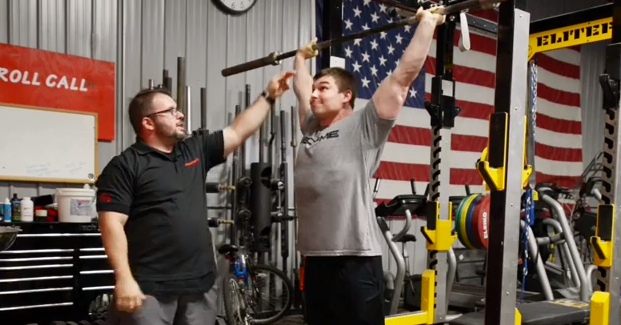
Elitefts.com Director of Education Mark Watts outlines a teaching progression of beginning athletes for the overhead press. Derek Dolgner demonstrates a 4-step exercise progression to implement with athletes to utilizing attainable positions and easily comprehensible teaching cues for all levels for athletes.
Overhead Press Progressions for Athletes
- Behind the Neck Press
- Military Press
- Behind the Neck Push Press
- Push Press
Basic Tips for Technique for the Military (Overhead) Press
- Make sure the your elbows are directly under or slightly in front of your middle and index fingers. Keep your forearms in a vertical path.
- Push your elbows forward before you press. This will keep your upper back tight. The key is not to let your shoulders come forward allowing the bar to start too far in front of too low on the deltoids.
- Think of opening a window and looking out of it when pressing. This will help you “negotiate your face" and keep the bar closer to your Center-of-Gravity.
- Pull the bar apart and and try and rotate your biceps forward with your hands facing out (you wont be able to because of the barbell) Attempting to do this will help in the lockout (along with pushing your head through).
Basic Tips for the Push Press
- Feet should be at hip width or slightly wider with "soft" knees.
- Lift your toes in your shoes to ensure the weight is on your heals.
- Dip down by pushing your hips back slightly while not allowing your elbows to drop.
- Drive the weight up by extending your hips and knees and "launch" the weight of your shoulders to lockout. Upper body technique is same as overhead press.
Programming Considerations
- Because the OHP generally is used with lighter weight than the squat, bench, and deadlift, the improvements are going to be in smaller increments as well. I am not trying to be condescending, but this is one way to look at it. For example, if your squat is 350 and your OHP is 150 a 10 pound jump for each is drastically different. That is a 2.8% increase in the squat and a 7% increase in the OHP. So it requires so much more diligence for every pound you can get.
- The first rep starts with a concentric contraction and there is no stretch reflex. Much like the deadlift although you need to statically hold the bar in place before you press it. Overcoming inertia while supporting the weight (that may be contradictory), makes it much more difficult.








